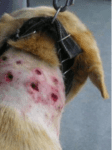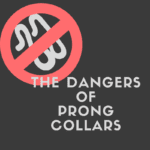
Lots of dogs pull on a leash when they are going for a walk. From trying to chase the squirrels to over excitement, pulling on a leash can cause harm to both the dog and handler. One tool that many people suggest is a prong collar. Prong collars are not the best tool for this for many reasons. Let’s talk about the dangers of prong collars and advocate for their extinction.

What Are Prong Collars?

A prong collar is a series of chain links connected to each other where the open portion faces the dog’s neck. The back of the prong collar has a chain loop where the leash connects.
When the dog is wearing the prong collar, as they pull the chain links tightens and causes a pinching on the dog’s neck skin. When the dog feels the discomfort of the pinching they ultimately stop pulling on the leash.
What Are The Dangers of Prong Collars?
Poor Training Device
The prong collar is not the best way to teach dogs to stop pulling. There is no training technique taught. All the owner does is add this device and mask the behavior.
If you take the prong collar off and switch back to a flat collar, will the dog still not pull? Most likely they will go back to pulling like they used to. Dog’s understand equipment just as much as we do.

The best way to teach a dog not to pull is to teach them a heel command and then match it with a better piece of equipment. If you are not sure on how to teach your dog heel, reach out to a dog trainer.
Also, using a prong collar creates positive punishment. Positive punishment means that when a dog has a behavior, a punishment is the outcome. This is not a great training technique especially when the punishment is pain. There are other ways to train this behavior out of a dog without creating a painful outcome.
Circling back to the masking behavior we just touched on. Lots of dog trainers will use a prong collar when it comes to reactive dogs. Adding a prong collar makes the reactive dog look so much calmer because they can no longer bark and lunge at the end of their leash.
But did that fix the problem? Once the prong collar is removed, the dog will still be reactive. The best way to help is to teach them to work through their reactivity with the proper gear on. Make sure you are bringing in the right dog trainer when it comes to reactive dogs. Someone that will fix the problem, not mask it.
Injury To Dogs

There are an abundance of injuries that prong collars can cause to dogs. For those dogs that have used a prong collar for a short amount of time, they can be subject to whiplash, fainting, and bruising of the esophagus.
If a dog repeatedly uses a prong collar and continues the behavior of fast jerking motions then more serious damage can occur. They could potentially suffer from bone fractures, dislocated neck bones, spinal cord injuries, or crushed treaceas.
The longer a dog uses a prong collar, the more damage can be happening beneath the skin. On the skin, the prong collar can leave behind puncture wounds which would need veterinarian attention immediately.
Better Options For Dog Owners
As mentioned above, the best way to teach your dog to stop pulling on a leash is to train them to do so. Reach out to a dog trainer or do your own research and start that process as soon as possible. Once that has begun, here is a list of better tools to use to help the process along.
EasyWalk Harness

The EasyWalk Harness is specifically designed to support your dog’s physique while preventing pulling. There are three straps; one that goes across the chest, one that goes under the legs, and one goes across the back. It then hooks in the front. This prevents excessive pulling.
This harness is great because not only does it reduce pulling but it supports the dog so there is no way to damage the neck area.
Head Halter

The Head Halter is a device that goes around the dog’s muzzle and clips behind their ears. It was designed to mimic a horse’s bridle. It balances the support around the muzzle to avoid neck injuries. Some of these are designed to shut the mouth too if the dog becomes a bite risk.
I always recommend this device for my clients with reactivity. This helps control reactive dogs to help them work through their triggers. It also helps prevent fatigue in the handlers because there is less pulling and lounging.
Martingale Collar

A Martingale Collar is the best type of collar one can get for their dog. It appears as a regular collar but has a built in loop that tightens the collar if there is excessive pulling. I love these collars because you can nag at the leash which causes the collar to close and open, to redirect your dog. The dog will feel the motion and if you connect it with a command, they will start to redirect to you instead of pull.
Hear It From Other Resources
This is a list of resources from other professionals and their research done on the dangers of prong collars.
Behavior Problems Of The Dog & Cat by G. Landsberg, W. Hunthausen, L. Ackerman
